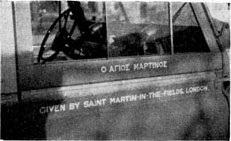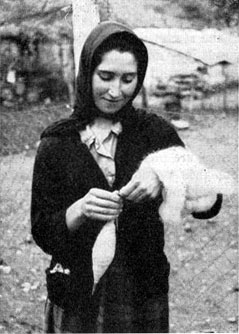- Obituaries
- Publications
- British Politics
- Greece
- Cyprus
- Spain
- Family
- Photos

Here comes St. Μartin's!
`Here comes St. Martin!' It is Monday morning in Pili, rain is beating down on the red-tiled roofs of the cottages and collecting in muddy yellow torrents on the earth tracks, and round the corner splashes a familiar grey landrover with the words—St. Martin-in-the-Fields written on the side. The word passes round the village quickly as Dr. Savvides and Miss Filla, the Greek doctor and midwife of the Prokopion area of Euboea climb out of the vehicle and open up the room which serves as the village surgery once a week. Soon there is a crowd of people, suffering from coughs, aching shoulders, painful feet or that bashful look which signifies that a private consultation with Miss Filla is desired.
Pili is a village of about 800 inhabitants situated amongst pine-clad hills on the coast of Euboea. During the Second World War it was occupied by Italian and German forces and later, during the civil war the whole village was evacuated and the houses burnt. Since that time, fifteen years ago, the villagers have settled back into Greek village routine, with the same features and the same problems as most villages in the area. Each family has a small sparsely-furnished cottage with a shed for the animals usually a couple of goats, a mule, a few hens and perhaps a donkey or a pig. Outside the house is a whitewashed dome-shaped clay oven and open fireplace where food is cooked in the summer. In winter, wood-burning stoves and open fires are used for cooking and heating.
 The flat land round the village is cultivated and each family has two to four acres of wheat, maize and beans, a few fruit trees and a vineyard. The men work either in the forest, felling timber and gathering resin from the pine trees, or in the magnesite mines and kilns nearby. Some of the older boys help with the resin, which is used in plastics and varnishes, but many have left Greece to find more lucrative employment elsewhere. Their sisters sort the white magnesite stone which is the raw material for firebricks and insulating material, or help their mothers with housework, fieldwork, weaving and sewing for their dowries.
The flat land round the village is cultivated and each family has two to four acres of wheat, maize and beans, a few fruit trees and a vineyard. The men work either in the forest, felling timber and gathering resin from the pine trees, or in the magnesite mines and kilns nearby. Some of the older boys help with the resin, which is used in plastics and varnishes, but many have left Greece to find more lucrative employment elsewhere. Their sisters sort the white magnesite stone which is the raw material for firebricks and insulating material, or help their mothers with housework, fieldwork, weaving and sewing for their dowries.
Families are large and most mothers tell tragic stories of miscarriages, infant illness and death. The mothers, themselves, are prematurely old and carry out their arduous tasks in spite of anaemia and ill health. Food is scarce, particularly in the winter and the diet is unimaginative, based on bread, beans and other pulses and paste supplemented sometimes by homemade cheese and eggs and occasionally meat—usually goat. Fruit and vegetables are grown but have only a limited season. The children are small and frequently ill. They attend school from six years of age and unless they go on to high school they leave school at the age of twelve.
Pili is more fortunate than many villages as it is near the sea, thus making fresh fish available. Bathing is rare as the villagers tend to fear and avoid exposure to the sun and the sea—their two most beneficial commodities. The fifteen kilometres of unsurfaced track which links Pili with the main road is open all year and twice weekly a battered bus conveys passengers and their luggage, be it chickens, wine or a new frying pan. Many villages are inaccessible to vehicles in the winter and some can only be reached by mule even in summer.
Two years ago piped water from a small reservoir in the hills was brought to each household in Pili. This has enabled families to improve their standards of hygiene and to keep small kitchen gardens. Other villages have to rely on communal fountains or wells and although the winter rainfall is torrential, the summer brings drought.
 These people are a contradictory mixture. In spite of their poverty and ill health they are cheerful and generous. One sometimes wonders which is the under-nourished party as one leaves a tiny cottage laden with gifts of eggs, apples and home made bread, but to refuse them would be to cause offence. They want to be `modern' but they have an uncanny knack of adopting all the brash, shiny aspects of the modern world, rejecting the developments of lasting value and at the same time discarding some of the worthwhile features of their traditions. Thus the young girls scorn the good hard-wearing handwoven goods in favour of readymade blankets and carpets in garish designs, and no new house is complete without a pot of brilliant plastic flowers.
These people are a contradictory mixture. In spite of their poverty and ill health they are cheerful and generous. One sometimes wonders which is the under-nourished party as one leaves a tiny cottage laden with gifts of eggs, apples and home made bread, but to refuse them would be to cause offence. They want to be `modern' but they have an uncanny knack of adopting all the brash, shiny aspects of the modern world, rejecting the developments of lasting value and at the same time discarding some of the worthwhile features of their traditions. Thus the young girls scorn the good hard-wearing handwoven goods in favour of readymade blankets and carpets in garish designs, and no new house is complete without a pot of brilliant plastic flowers.
Their idea of a doctor's job is a mixture of ancient remedies and modern new drugs. They demand to be treated by cupping and bleeding, massage with oil and ashes and doses of camomile tea—but topped up with a `magic' injection of the latest and most expensive drug available. Meanwhile they slip round to offer an effigy of the afflicted part to their favourite saint. They are very inquisitive and ask more questions about the doctor than the doctor asks about them. The concept of preventive medicine is incomprehensible to them, and for this reason the young Greek midwives have a hard time trying to convey the value of regular ante-natal care to a population which has been used to calling for the `practical women' at the last minute to deliver the baby and instruct in all the ancient rituals associated with village childbirth.
At first they regarded with suspicion the examination of healthy children as well as the ill, but gradually they are accepting the idea of prevention. The younger women especially are demanding the services of the trained midwives and asking for advice on the care of the children.
One feels that if these young mothers can be taught the sensible healthy ways of housekeeping and parenthood, the whole standard of health and hygiene in these villages can be raised and progress can be directed along desirable channels without losing the traditions of these friendly, happy people.
SHEENA BLACKBURN
 Published in St. Martin's Review, December 1965
Published in St. Martin's Review, December 1965
 Home Page
Home Page